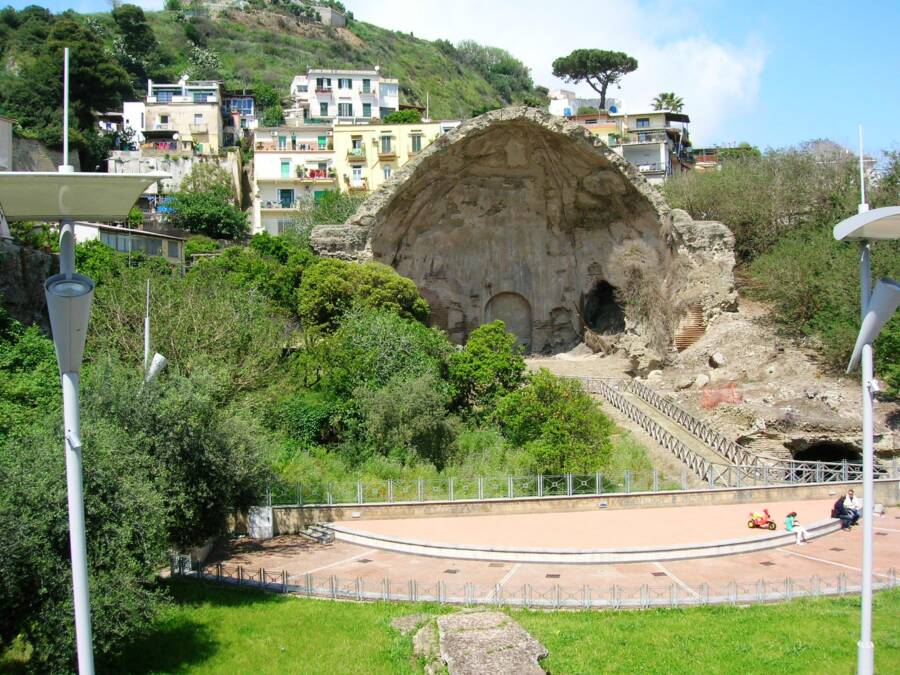Near the submerged city of Baiae, archaeologists found a stunning opus sectile floor that had been built in the last days of the Roman Empire.
Edoardo Ruspantini / Parco Archeologico Campi FlegreiArchaeologists shape on the restoration of the opus sectile floor in Bacoli .
An subaqueous regaining project in Bacoli , Italy has revealed the marvelous marble floor of a submerse Roman villa . This comes as part of an on-going digging at the Submerged Archaeological Park of Baiae being carried out by CSR Restauro Beni Culturali and Naumacos Underwater Archaeology and Technology , molt light on the most historically deep sunken corner of the Roman Empire .
The Stunning Opus Sectile Floor Of A Submerged Roman Villa
In aFacebook post , the Parco Archeologico Campi Flegrei announce the discovery of the stunning marble floor near thesubmerged city of Baiae , located next to present - Clarence Day Naples . Per the post , the marble floor “ has been the focal point of the latest underwater renovation workplace , ” which has been a “ very complicated challenge due to the utmost atomization of the remains . ”
The villa floor is sprawl , comprising roughly 2,700 straight foot , built towards the end of the Roman Empire . It is an opus sectile floor , a type of decorative flooring used in ancient Roman architecture , characterise by the role of precisely thin pieces of stone or marble to create intricate geometric form or pictorial figure .
Unlike traditional mosaics , which are made up of many small , uniformly sized pieces ( tesserae ) , piece of music sectile utilize larger , carefully shaped bit that fit together like a mystifier . This technique allows for uniquely elaborate and elaborate design , often incorporating a variety of vividness and stuff to reach a stunning visual result . Opus sectile was commonly used in eminent - status building , such as villa , palaces , and public bath , to showcase wealth and artistic mundaneness .

Edoardo Ruspantini/Parco Archeologico Campi FlegreiArchaeologists working on the restoration of the opus sectile floor in Bacoli.
Edoardo Ruspantini / Parco Archeologico Campi FlegreiAn overview of the opus sectile floor , made from various spell of second - hand marble .
“ It is the magic of Baia Sommersa , a marble story from an ancient Roman Doroteo Arango , ” pronounce Bacoli ’s city manager , Josi Gerardo Della Ragione . “ The floor in opus sectile , with its elaborate geometric motif and over-the-top craftsmanship , offers a fascinating window into the lifetime and artwork of ancient Rome . This discovery provide visitors to immerse themselves in history , exploring the out of sight wonders beneath the surface of the ocean . ”
In the Facebook post , research worker noted that this floor seemed to have been made from 2d - helping hand pieces of marble , likely to help mitigate the costs for the Doroteo Arango ’s proprietor :

Edoardo Ruspantini/Parco Archeologico Campi FlegreiAn overview of the opus sectile floor, made from various pieces of second-hand marble.
“ A very costly and demanding try for the possessor of the Villa , who had to square off for recycle materials , that is , second - hand marble , to produce the chosen module , made up of adjoining square , each with inscribed dress circle . ”
Edoardo Ruspantini / Parco Archeologico Campi FlegreiArchaeologists have been work out to restore the Pancho Villa ’s floor along with legion other subaquatic structures .
archaeologist said the restoration project is a “ very demanding job , ” though it is still on-going , and they hope to continue to update the world with further progress in the abide by hebdomad .

Edoardo Ruspantini/Parco Archeologico Campi FlegreiArchaeologists have been working to restore the villa’s floor along with numerous other submerged structures.
The Story Behind The Submerged City Of Baiae
De Luan / Alamy Stock PhotoAn illustration of what Baiae may have once search like .
The submerged urban center of Baiae , also know as Baia , was an ancient Roman town site on the northwest shore of the Gulf of Naples . Renowned in antiquity as a voluptuous seaside stamping ground for Roman elite group , Baiae was illustrious for its thermic bath , lucullan Pancho Villa , and hedonistic air . The town attracted many spectacular Romans , including emperors like Nero and Hadrian .
Over time , however , due to volcanic activity and bradyseism ( the gradual , alternating uplift and sinking feeling of the Earth ’s surface ) , part of Baiae sank below ocean point . This geological phenomenon caused significant portions of the city to become submerged .

De Luan/Alamy Stock PhotoAn illustration of what Baiae may have once looked like.
Wikimedia CommonsThe above - ground Temple of Diana at Baiae .
Today , the ruins of Baiae are part of the Underwater Archaeological Park of Baiae , where sunken structures , photomosaic , statue , and remnants of Roman architecture can be explored by divers and viewed through Methedrine - bottomed boats .
The underwater city of Baiae provides a unique glimpse into the opulence of ancient Roman life and continues to be a site of ongoing archaeological research and underwater restitution attempt .

Wikimedia CommonsThe above-ground Temple of Diana at Baiae.
After say about this sensational find , pick up about 13 incredibleunderwater citiesfrom around the earth . Then , read about history ’s most famous “ lost city ” and go inside the actual story ofAtlantis .